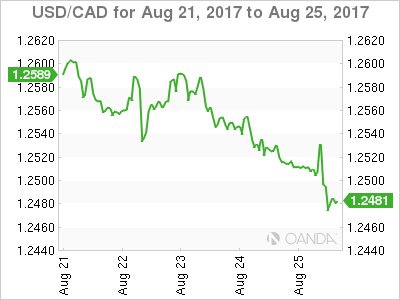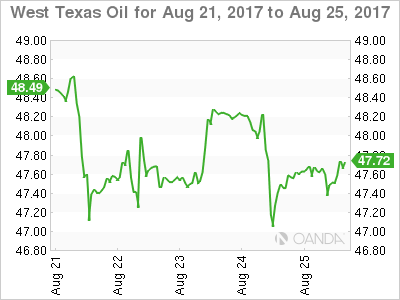The Canadian dollar will end the week higher against the dollary after disappointing durable goods data in the US and few details out of the central bank summit in Jackson hole offered little support for the currency that has been bogged down by political turmoil.
The loonie has been decoupled from oil prices as crude ended the week on a negative note even as Hurricane Harvey could disrupt Gulf energy producers. NAFTA talks have grabbed headlines as Donald Trump has once again threatened to pull out of the trade deal. In an effort to have a more productive first round of negotiations the three nations have signed NDAs. The trade talks kick off on September 1 in Mexico.
US employment will guide markets as the ADP private payrolls report to be released on Wednesday, August 30 at 8:15 am starts the jobs data rollout. Analysts are forecasting a 186,000 job gain following the 178,000 jobs added in July. The biggest indicator will be released on Friday, September 1 at 8:30 am when the Bureau of Labor Statistics publishes the U.S. non farm payrolls (NFP). The last two months have exceeded expectations and the market is anticipating a 180,000 addition of new positions in August. Inflation data in the job reports will be highlighted as the Fed appears to be slowing down on it’s tightening policy as wages and prices remain sluggish even as the number of jobs have been steady throughout the recovery.
Canadian data will be scarce next week with the release of the gross domestic product (GDP) the main highlight to be released on Thursday, August 31 at 8:30 am EDT. Growth is anticipated to have slowed down in June with a 0.1 percent gain. Despite the lower gain the Canadian economy would have advanced 3.7 percent in annual terms, but could grow below 2 percent in the second half of the year. The lower growth will not be enough to derail the expected Bank of Canada (BoC) rate hike in October. Another 25 basis points could be added to the benchmark rate after the two rate cuts in 2015 in response to falling oil prices are no longer needed.

The USD/CAD lost 0.696 percent in the last week. The pair is trading at 1.2490 and is near weekly lows after the USD continues to retreat against the loonie despite lower oil prices. US durable good fell on Friday and with little support from Janet Yellen at Jackson hole the USD kept depreciating against the Canadian currency.
The US currency has been bogged down by political turmoil as Donald Trump has issued statements on the debt ceiling and NAFTA negotiations that have put downward pressure on the dollar. The US, Canada and Mexico have signed a non-disclosure agreement (NDA) on their trade talks as the uncertainty of the outcome reached a new low this week. Both the US and Mexico would like a speedy resolution ahead of elections in 2018, but with the Trump administration’s comments negotiations could end sooner, but with a negative outcome for all nations.

Oil rose on Friday but will remain 1.895 percent in the red for the week. The price of West Texas Intermediate is trading at $47.73 as crude inventories continue to drop in the US, a weak dollar and Hurricane Harvey could not offset the drop in the price of energy. The Organization of the Petroleum Exporting Countries (OPEC) has left all its options open as the production cut agreement has only stabilized prices but has failed at driving prices higher. Production disruptions have been the only factors moving prices higher, but that is not a sustainable strategy and despite the optimism from OPEC members there is still a long way to go toward a rebalancing of the market.
Compliance with the production cut agreement were near 100 percent before July, but have now dropped to 75 percent levels among OPEC members and even lower for other producers that signed the deal. The seasonal increase from Saudi Arabia was the biggest blow as the major backer of the agreement it had at one point overcut its production to bring the deal under full compliance.
The Energy Information Administration (EIA) will release US crude inventories on Wednesday, August 30 at 10:30 am with another drawdown of 3 million barrels expected. The impact of Hurricane Harvey could end up limiting US output. Oil production in the US has gone up dramatically and is one of the reasons prices have been low as the OPEC has not been able to reduce the global glut as demand has not grown on par with supply.
Market events to watch this week:
Tuesday, August 29
- 10:00 am USD CB Consumer Confidence
Wednesday, August 30
- 8:15 am USD ADP Non-Farm Employment Change
- 8:30 am USD Prelim GDP q/q
- 10:30 am USD Crude Oil Inventories
- 9:30 pm AUD Private Capital Expenditure q/q
Thursday, August 31
- 8:30 am CAD GDP m/m
- 8:30 am USD Unemployment Claims
- 9:45 pm CNY Caixin Manufacturing PMI
Friday, September 1
- 4:30 am GBP Manufacturing PMI
- 8:30 am USD Average Hourly Earnings m/m
- 8:30 am USD Non-Farm Employment Change
- 10:00 am USD ISM Manufacturing PMI
*All times EDT












